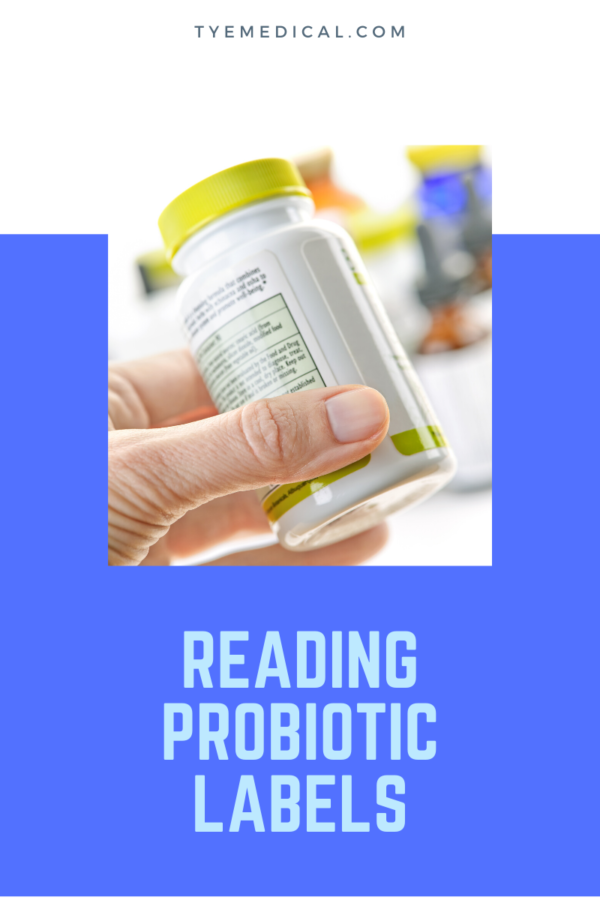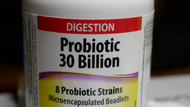How to Reap the Benefits of Probiotics that Target Your Symptoms
Written by tyemedical on Jun 23rd 2020
You’ve probably wondered about the benefits of probiotics – because they’re everywhere! Over the last ten years probiotic supplements have exploded all over store shelves and inundated e-commerce sites. So should you be taking them? How do you know which type to use? And more importantly, how much should you take? These are important questions, because probiotic supplements are pricey, and no one wants to throw money away. In this article, we help you understand how to read labels, choose an effective product, and how to target your troublesome symptoms.
What Are Probiotic Supplements?
Probiotics are live microorganisms or “good bacteria” that live naturally in your gut or intestines. Many doctors refer to these good bacteria as intestinal flora (gut flora). They help you properly digest your food for nutritional absorption, support your immune system, and make vitamins like biotin and vitamin K.
You don’t have to rely on your body or diet alone to maintain your probiotic levels. Since your flora are sensitive guys and gals, they can be tricky to maintain. Even too much stress is known to affect them! So, doctors who understand the benefits of probiotics recommend using supplements to help keep your system in balance.
What Happens If Your Gut Is Low in Good Bacteria?
When you have enough of the right kinds of flora in your gut, everything hums along. But when things go awry in your system, whether due to dietary issues, food sensitivities, environment, or antibiotic use, those good guys die off and the “bad bacteria” invade your gut. This lack of good bacteria in your intestines can lead to a host of health conditions ranging from vaginal yeast infections, to diarrhea, constipation, leaky gut, eczema, some types of cancer, and autoimmune disorders.
 How Do I Read Labels on Probiotics?
How Do I Read Labels on Probiotics?
You’ll be better equipped to navigate the world of gut health if you understand what those complicated labels mean. Here’s a helpful overview with recommendations so you can make sense of it all!
Strains
Strains refer to the number of bacteria strains (or types of bacteria) in the product. Many companies claim that more is better when it comes to the different types of bacteria in your probiotic supplement. While it’s true that you have over 500 different varieties of probiotics naturally in your gut, science hasn’t confirmed that all of these are effective in supplement form.
Therefore, to reap the benefits of probiotics for general health, most experts agree that various strains of Lactobacillus, Saccharomyces, and Bifidobacterium are effective in supplement form for boosting and maintaining gut health. Later, we’ll discuss how to target specific symptoms using different strains of bacteria in probiotic supplements.
CFU
CFU refers to colony-forming unit, which is a technical way of saying how many individual live micro-organisms are in each serving. So, 10 billion CFU means there are 10 billion live bacteria in each serving at the time of manufacture or testing. That might seem like a lot, but remember how sensitive these bacteria are, so you want to start with a large number to ensure enough survive the trek to your intestines.
There’s no set dosage for probiotics, because each person has different needs. Also, no one knows exactly how many live bacteria you’re getting with each dose. So, the general rule of them is that the average person benefits from ingesting anywhere from 1 billion to 10 billion colony-forming units (CFU) per day. You can’t overdose on probiotics and taking more than you need won’t harm you. This means you’ll want to buy a supplement with a higher CFU than your probiotic goal.
How and When Do I Take It?
Some doctors recommend splitting your daily dose, (i.e. take 10 billion CFU twice daily), but many labels suggest taking one 20 billion CFU capsule a day. Follow your doctor’s recommendations or the product label.
When it comes to taking it on an empty stomach or with food – it doesn’t matter much if the probiotic is enteric-coated (plastic-like capsule) or uses delayed-release capsules. That’s because these forms are designed to better withstand stomach acid. Take them when it’s convenient for you.
However, if your probiotic supplement has live bacteria (requires refrigeration), then it’s best to take it 20 minutes after you eat, first thing in the morning, or before bed. Some strains of probiotics are based taken with a meal and this should be indicated on the label.
Live Cultures VS Freeze-Dried
You will see live and active cultures on many food products like yogurt. Many supplements include live (but not yet active) cultures. Live bacteria require refrigeration toprolong shelf-life, so carefully read your label to see if you must store your probiotic supplement in the refrigerator. Temperatures over 115 degrees kill off probiotic bacteria, and exposure to moisture activates them prematurely. If you want all the benefits of probiotics, ensure your supplement remains cool and dry (exposed to as little humidity as possible).
Many probiotics don’t require refrigeration, because the bacteria are freeze-dried (but still alive) to seriously extend shelf life and minimize incidental loss. You don’t have to store this type in the refrigerator, but you will want to keep them at or below room temperature without exposing them to humidity. If you’re still concerned about shelf stability, then buy supplements in blister packaging so that each capsule is sealed in its own pocket until you take the dose. Even though the cultures aren’t active now, they’ll become active when exposed to the humidity in your system.
 What Makes a Good Probiotic Supplement?
What Makes a Good Probiotic Supplement?
You have tons of options when it comes to buying probiotics. So, you’ll want to find a good brand with some of these characteristics before zeroing in on details like strains and CFUs.
Third Party Testing
Not all supplements are created equal – and remember that the FDA doesn’t regulate them. This means that the label is only as good as the manufacturer’s word. You could end up buying a bunch of dead bacteria that will be of no help to you.
We keep probiotic brands honest through third party testing. Reputable lab companies test the product to verify that it contains the number of live strains and the amount of CFUs it claims to have. Typically, manufacturers indicate third party testing on the label, and you can always head to the company website for more information.
Guaranteed Potency Until Expiration Date
Even after third party testing, it’s comforting to have some indication that your probiotics will remain effective. It’s inevitable that some bacteria will die during the long process of manufacturing, testing, shipment, and traveling to your gut. So reputable companies will guarantee a minimum potency per serving until expiration date. After all, you want to get all the benefits of probiotics, especially when you consider their cost.
For example, a product that advertises 40 billion CFU might guarantee a minimum of 20 billion CFU per serving until expiration. If you wonder why you see such high CFUs on many labels, it’s because many bacteria will die off even with a quality product. If you start out with higher CFUs and store it right, you should still end up with plenty of probiotics.
Allergen-Free
Many supplements contain fillers and are dispensed through manufactured capsules that also contain additional ingredients. If you have any sensitivities or allergies to gluten, soy, dairy, GMO ingredients, etc., you’ll want to look for a probiotic supplement that’s allergen free. And even if allergies aren’t an issue for you, you might want to opt for these brands anyway to cut down on fillers.
How Do I Buy the Right Probiotics for Me?
As we mentioned above, if you’re interested in maintaining general and digestive health, look for products that contain the various strains of Lactobacillus, Saccharomyces, and Bifidobacterium. They’re the most researched strains and have proven to be effective when taken as a supplement.
But what if you want to combat a specific condition with probiotics? How will you know which strains will work best for your needs? Here’s a list to help you target the right conditions with the right probiotic strains.
Probiotic Strains for Your Health Conditions
Best for antibiotic-related diarrhea:
- Lactobacillus rhamnosus GG
- Saccharomyces boulardii
- Lactobacillus rhamnosus GG
- Lactobacillus acidophilus
- Lactobacillus bulgaricus
Best for Constipation:
- Bifidobacterium lactis
Best for Diarrhea-Predominant IBS:
- Bacillus coagulans
- Saccharomyces boulardii
- Combined strainsof Lactobacillus and Bifidobacterium
Best for Ulcerative Colitis:
- Lactobacillus gasseri
- Lactobacillus rhamnosus
- Combined Lactobacillus rhamnosus and Bifidobacterium lactis
Best for Supporting Brain Health (anxiety, depression, memory):
- Bifidobacterium longum
- Bifidobacterium breve
- Bifidobacterium infantis
- Lactobacillus helveticus
- Lactobacillus rhamnosus
Best for Heart Health (lower LDL cholesterol):
- Lactobacillus acidophilus
- Bifidobacterium longum
- Lactobacillus reuteri
Best for Boosting Immunity:
- Lactobacillus GG
- Lactobacillus crispatus
- Lactobacillus gasseri
- Bifidobacterium bifidum
- Bifidobacterium longum
Benefits of Probiotics Outweigh Cost
Yes, you can try to get enough probiotics through food. It doesn’t hurt to have some low sugar, low calorie yogurt with live and active cultures. You can even enjoy some kombucha tea sold at your local grocery store, but it’s not always easy to keep these fermented foods in supply or to know how many probiotics you’re getting in a day.
Opting for a high-quality probiotic might be your best bet. Just be careful not to lower your standards for a cheaper price. If you’re not getting live cultures that become activated in your system, then you are wasting every penny you spend!
 Managing Incontinence While Caring for Digestive Health
Managing Incontinence While Caring for Digestive Health
As you consider the right probiotic to optimize your health, also consider premium products for leak protection. Stay clean, dry, and worry free with our line of LivDry products. Our protective underwear offers all the right features:
- Leakage barrier leg cuffs
- Super Absorbent Gel Core
- Cloth-like stretch panels for a comfortable fit
- Colored stitching to indicate front
- Tear-away sides
- Discreet protection
- Can be used with our two-piece system
Shop now for free shipping!

